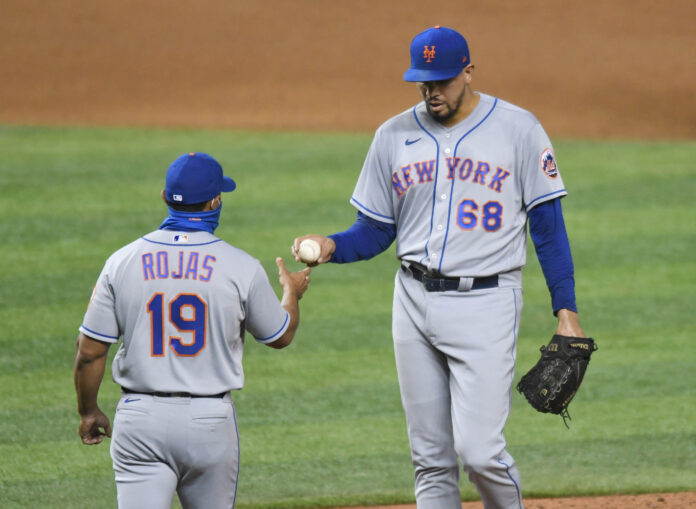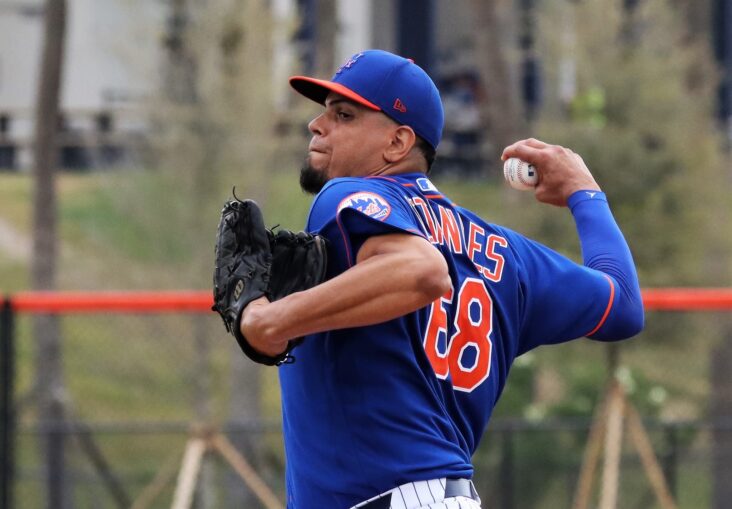Will Dellin Betances Return To The Mets Next Season?

Aug 19, 2020; Miami, Florida, USA; New York Mets relief pitcher Dellin Betances (68) gives the ball to manager Luis Rojas in the 8th inning at Marlins Park. Mandatory Credit: Jim Rassol-USA TODAY Sports
Following a horrendous overall performance from the bullpen in 2019, the New York Mets knew they needed to add multiple quality relievers during the offseason, which ultimately resulted in the signing of Dellin Betances.
After spending his entire career in the Bronx, the 32-year-old decided to part ways following his injury-riddled 2019 campaign and drove 30 minutes south on the I-295 to Queens. Despite his recent health concerns — shoulder, lat, and Achillies injuries — general manager Brodie Van Wagenen signed the veteran hurler to a one-year, $10.5 million contract that also included a pair of player options over the next two seasons.
While the Mets were hoping Betances would be able to bounce back strong just one season removed from rupturing his Achilles, the former New York Yankee struggled to stay on the field for the second consecutive campaign. To make matters worse, he produced one of the worst seasons of his entire career, which significantly impacted the team’s bullpen in a negative way.
Since another lat injury limited him to just 15 appearances, the 6-foot-8 hurler compiled only 11 2/3 innings, recording a miserable 7.71 ERA, 5.65 xERA, 4.91 FIP, 6.39 xFIP, 183 ERA-, 112 FIP-, 143 xFIP-, 2.06 WHIP, .267 OPP AVG, .353 BABIP, 18.6% strikeout rate, 20.3% walk rate, 47.5% first-pitch strike rate, 32.4% LD rate, and 0.0 fWAR.
Adding to this, it seems Betances’ inability to stay healthy prevented him from replicating his overpowering high-90s fastball, as its velocity dropped down into the low 90s in the spring and averaged just 93.6 mph during the regular season. Along with his poor-performing heater, the third-place finisher in the 2014 AL Rookie of the Year race also failed to utilize his low-80s curveball effectively and couldn’t create nearly as many swings and misses with it compared to previous seasons.
Starting with his fastball, the right-hander threw it 49.0% of the time, generating a .278 AVG (.008 increase from 2018), .273 xAVG (.108 increase), .333 SLG (.008 increase), .344 xSLG (.035 increase), .405 wOBA (.033), .406 xwOBA (.050), 3.7% strikeout rate (21.5% decrease), 13.2% whiff rate (19.1% decrease), 10.3% in zone whiff rate (21.2% decrease), 13.4% chase rate (16.6% decrease), 29.6% walk rate (16.2% increase), and a 56.8% out of zone rate (8.3% increase).

Photo by Ed Delany, MMO
Unfortunately for Betances, the lack of velocity caused his four-seamer to sink a lot more and also resulted in less side-to-side movement while traveling toward home plate, as it averaged 19.6 inches of drop (an increase of 7.1 inches compared to 2018) and just 3.4 inches of break (decrease of 2.5 inches). As a result, this decline in movement made it an easier pitch to put in play and allowed hitters to lay off it during two-strike counts, as it induced a zero percent chase whiff rate in those situations.
Moving to his curveball, the four-time All-Star utilized it 41.1% of the time, producing a .286 AVG (.086 increase), .310 xAVG (.171 increase), .286 SLG (.023 decrease), .371 xSLG (.199 increase), .366 wOBA (.113 increase), .394 xwOBA (.212 increase), 15.8% strikeout rate (27.7% decrease), 30.3% whiff rate (16.7% decrease), zero percent chase whiff rate during two-strike counts (72.2% decrease), 28.6% chase rate with two strikes (29.5% decrease), 21.1% walk rate (14.6% increase), along with a 45.5% LD rate (12.2% increase).
Similar to his fastball, Betances’ breaking ball also endured a dip in velocity this past season, as its average velocity dropped down to 82.6 mph (1.7 mph decrease). That being said, the decline didn’t impact its vertical or horizontal movement, but it did provide opposing batters an extra second or two in the batter’s box to determine its location in the strike zone.
Based on these disappointing results, it certainly makes sense why some experts would be in favor of the New York native opting out of his current contract, especially since he’ll be entering his age-33 season in 2021. But considering this winter’s free-agent class is expected to feature tons of reliable arms like Liam Hendriks, Trevor Rosenthal, Jeremy Jeffress, Keone Kela, Shane Greene, and more, there’s a very solid chance the former eighth-round selection will exercise his $6 million player option for next season.
Along with the likelihood of Betances returning for a second season with the Mets, the towering righty could also come back in 2022, as his deal includes a vesting player option that could pay him upwards of $3 million if he makes 70 appearances next season. While there’s a chance he could spend a third season in Queens, if healthy, it would make much more sense for him to test the open market after the 2021 campaign and try to land a multi-year contract.
Looking ahead to next season, there are clearly many areas where the Grand Street Campus HS product will need to improve while also finding a way to maintain his overall health at the same time. That said, limiting hard contact and keeping balls on the ground are two areas the veteran pitcher won’t need to fix, as he excelled in both of those categories this past season.
Over his limited workload in 2020, Betances generated a 41.2% GB rate, 26.5% FB rate, 17.6% hard-hit rate (which would’ve been the second-lowest rating among all relievers if he qualified), an 82.5 mph average exit velocity, and zero hitters were able to barrel up any of his pitches.
Taking into account these metrics, the aging reliever probably would’ve been able to slightly improve his overall results if he could’ve stayed on the mound and completed at least 30.0 innings of work. While the lack of velocity on his fastball would’ve likely still hindered his ability to replicate his stellar results from earlier in his career, there’s a strong possibility the additional playing time could’ve helped him work through the issues with his secondary weapons.
With Betances likely to return in 2021, it’ll be crucial for him to arrive at spring training in excellent condition and he’ll need to hit the ground running to regain his high-leverage role within the Mets’ bullpen. If he can recapture some of the success from his time with the Yankees, then the club shouldn’t have any issues preserving leads next season, which should help their chances of making the playoffs for the first time since 2016.


